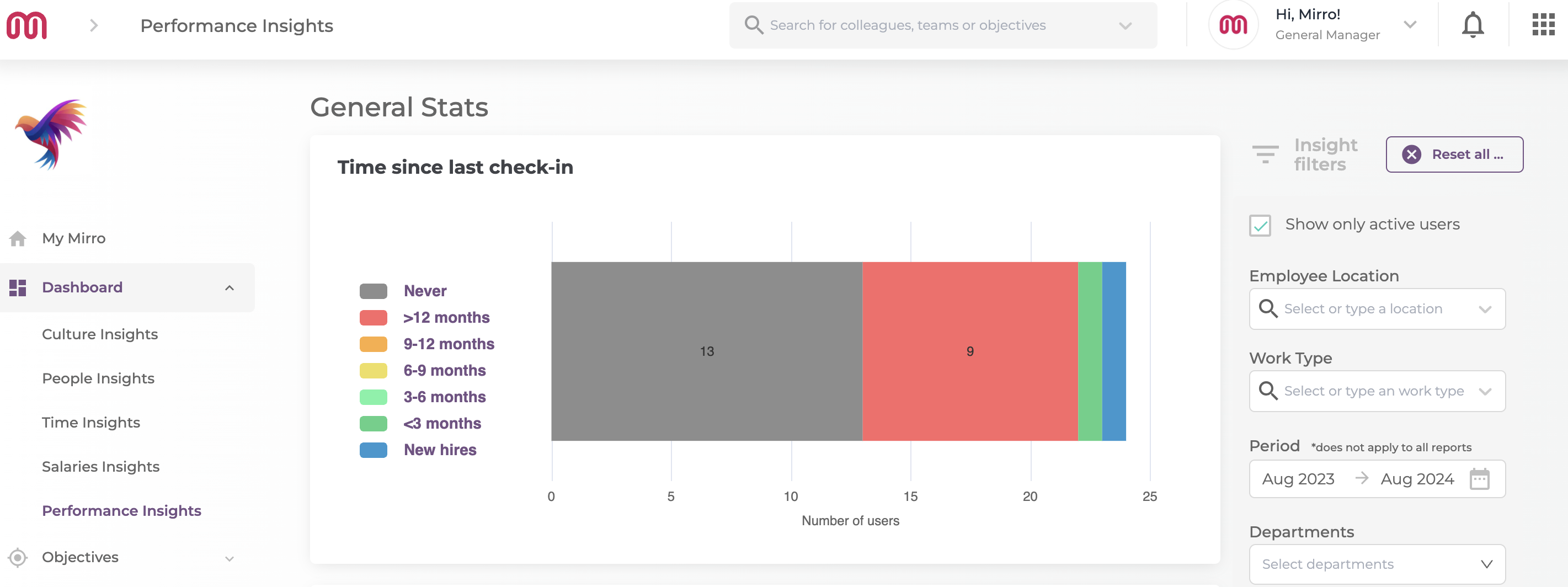SECTION
Navigating HR Compliance and Performance Management: Insights from the Mirro x Accace Webinar
-1.png)
Listen to this article:
HR leaders are under pressure to stay compliant while ensuring teams are aligned, engaged, and high-performing. Legislative changes create new risks, forcing companies to reassess how they manage performance management, feedback, evaluations, restructuring, and other key aspects.
That’s why we partnered with Accace, a leader in payroll, legal advisory, HR administration, tax, and BPO services, to host an expert-led webinar exploring the legal, strategic, and operational aspects of performance management—particularly in light of recent fiscal changes and increased employer responsibilities.
We brought together Silviu Constantin, Legal Director at Accace, who has deep expertise in legal frameworks and risk mitigation in HR processes, and Bogdan Ionita, Chief Product Officer at Mirro, who has a deep understanding of performance trends and how technology can drive fair and engaging performance management. Keep reading to discover their insights!
Why legal compliance in HR is a must-have
Silviu began the presentation with a strong statement: performance evaluations have direct legal implications. From accusations of discrimination to the collapse of disciplinary cases due to poor documentation, the risks are real and potentially costly.
The main risks involved in performance evaluations are:
- Harassment/Discrimination claims: Employees, increasingly aware of their rights, may claim discrimination if feedback or assessment results are hurtful or unfair, leading to moral damages, fines, and reputational harm.
- Corruption of the sanctioning/dismissal process: Poorly executed or documented performance processes can compromise the ability to sanction or dismiss low performers, potentially leading to court reinstatement and back pay.
How to avoid these pitfalls:
- Robust Regulatory Framework: Ensure your policies are in line with the law, up-to-date, and known to everybody involved in the process. An audit is highly recommended.
- Manager Training: Train managers to avoid biased language and focus on metrics rather than subjective impressions.
- Comprehensive Documentation: Document every piece of feedback, decision, assessment, and incident to protect the organization in the event of disputes. Clarity protects everyone.
- Ensure consistency in applying evaluation criteria across teams.
- Avoid linking evaluations too tightly to personal traits or lifestyles.
- Be careful when addressing underperformance—focus on facts, not assumptions.
- Performance Improvement Plans (PIPs): Although not legally mandatory for termination, PIPs are highly recommended by courts as a means to demonstrate efforts to support the employee. They should be meaningful but can be relatively short (e.g., 30-90 days). These good-practice measures also help organizations stay aligned with broader fairness and transparency expectations driven by the EU pay transparency directive.
Offboarding: strategy over surprise
Although offboarding is not necessarily a pleasant process, when it becomes necessary, the method matters. Poorly handled offboarding can damage morale, culture, and the company’s reputation. This is especially relevant as teams plan for budget adjustments or restructuring.
Here are your offboarding options:
- Mutually Agreed Termination (MTA): It is the preferred offboarding strategy because it is bilateral, flexible, confidential, and risk-free.
- Termination for Professional Unfitness: It is legally possible but requires airtight KPIs and evidence. It is unilateral, requires a specific procedure, and can be lengthy if the performance evaluation process is not properly done. It is classified as medium-risk.
- Disciplinary Dismissal: This is a high-risk, unilateral action taken only in specific cases. It requires intensive documentation.
- Redundancy: It is a low-to-medium risk and can be relatively legally clean if driven by a real business need and supported by objective selection criteria.
Here are the legal must-knows for offboarding employees correctly:
- Understand and follow local labor laws regarding underlying reasons, procedures, notice periods, and forms;
- Prepare proper documentation (depending on the termination path);
- Ensure final payments and benefits are calculated correctly;
- Communicate clearly to both the departing employee and the team;
- Let the lawyers do it!
What about AI?
As AI becomes more integrated into HR, the speakers warned against letting algorithms make final decisions—especially in hiring or performance scoring. AI promises us efficiency, but we must balance its power with responsibility.
Here are the experts’ legal takeaways on AI use:
- Try to limit the use of AI for supporting tasks (retrieval, consistency).
- Avoid autonomous decisions or CV screening.
- Maintain human oversight at every decision point.
Performance management in practice: how Mirro helps
In the final part of the webinar, we discussed best practices for company culture and how a performance management platform can help companies maintain compliance.
Bogdan highlighted how Mirro empowers HR leaders to meet legal obligations without sacrificing culture or engagement. Our platform helps ensure that performance reviews are not only compliant with local laws but also transparent, consistent, and human-centered.
With Mirro, you can preserve a culture of fairness in times of uncertainty by:
- Maintaining transparency even in tough decisions;
- Offering regular check-ins and manager support for teams;
- Reaffirming your core values during periods of change;
- Recognizing and celebrating team efforts, not just individual heroics;
- Reinforcing habits of feedback and recognition.
 Mirro's performance insights dashboard
Mirro's performance insights dashboard
Bogdan also emphasized how Mirro simplifies the performance journey: “We’ve designed it so managers and individuals alike can move through check-ins and reviews effortlessly. It’s intuitive, it prompts the right actions, and it captures everything you need—without adding overhead.”
Mirro transforms compliance from a burden into a built-in benefit—integrating it naturally into daily HR processes. So, if you have any questions or would like to explore how Mirro can help you stay compliant, let’s have a chat. We're always here to support you!
See you next time?
While the intersection of legal compliance and performance management can feel complex, the message is clear: structure, transparency, and fairness are your best allies. When HR platforms and policies are built to empower people—managers and team members alike—they not only reduce risk but also strengthen company culture.
Be sure to keep an eye out for our upcoming events; we’ll continue to bring expert insights to help you lead confidently through change. In the meantime, follow us on LinkedIn to stay updated and be the first to know about our next webinars.
What part of this webinar struck a chord with you most? We’d love to hear your thoughts, and we hope to see you at our next event!




.jpg)

